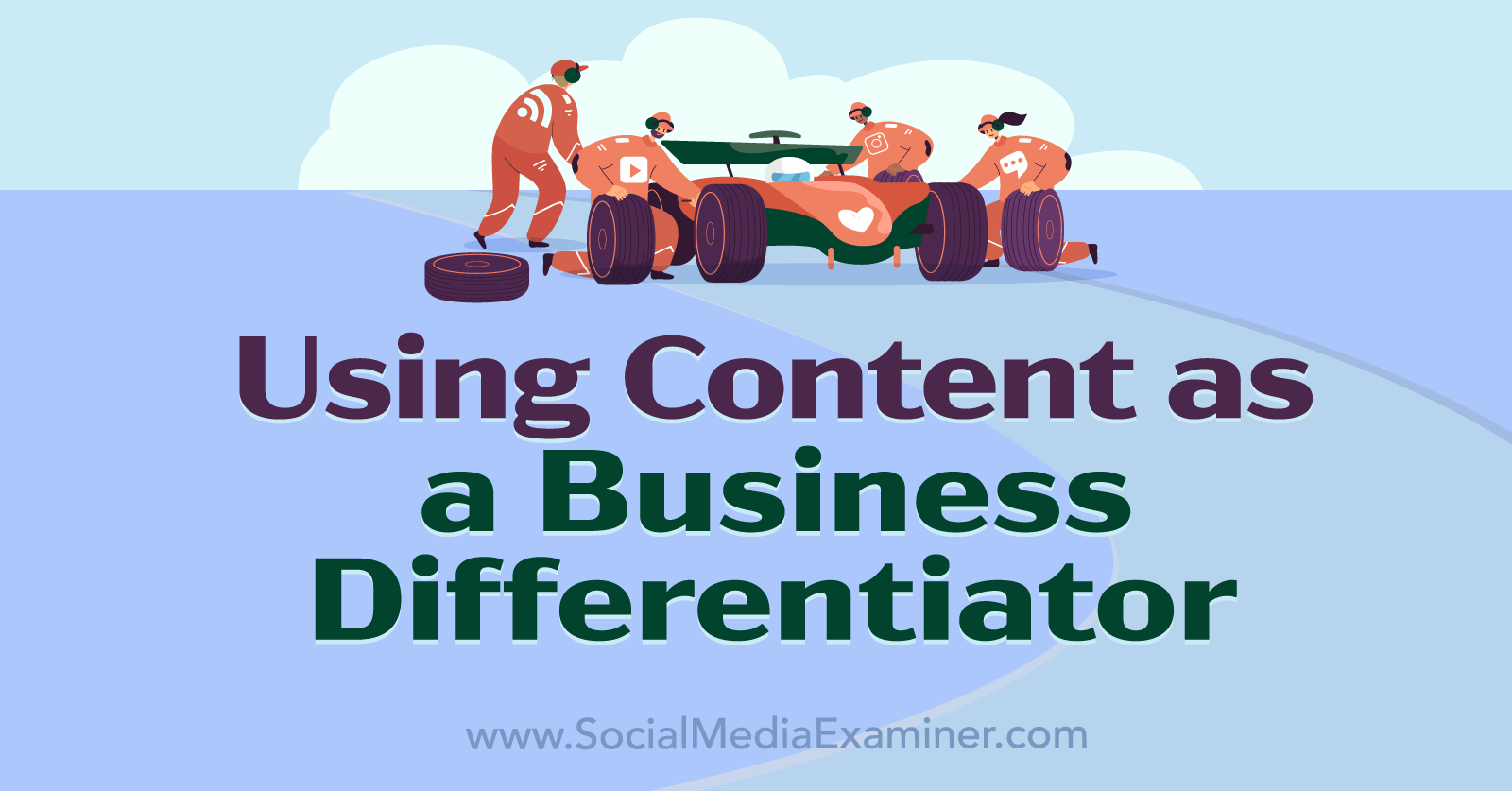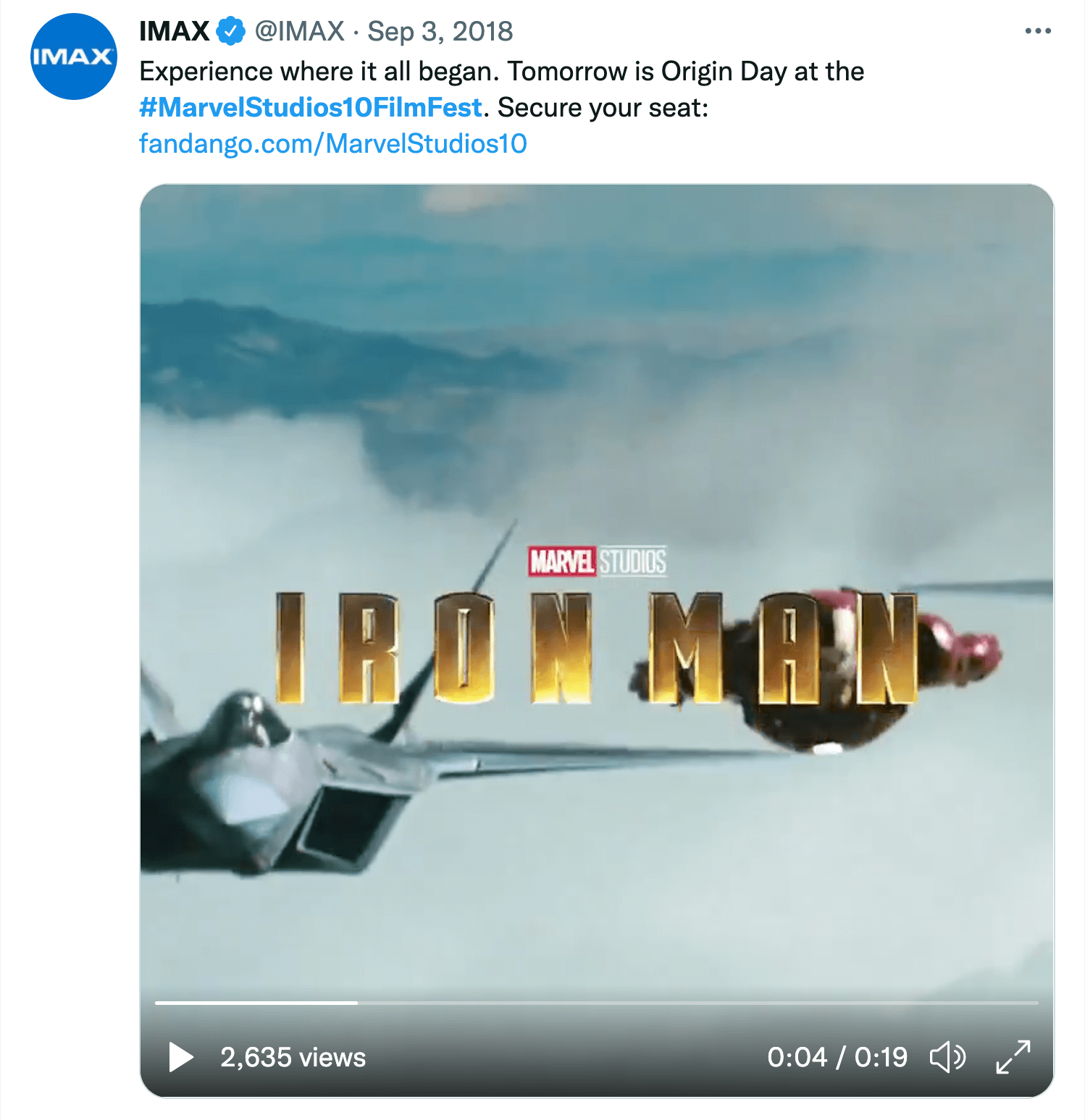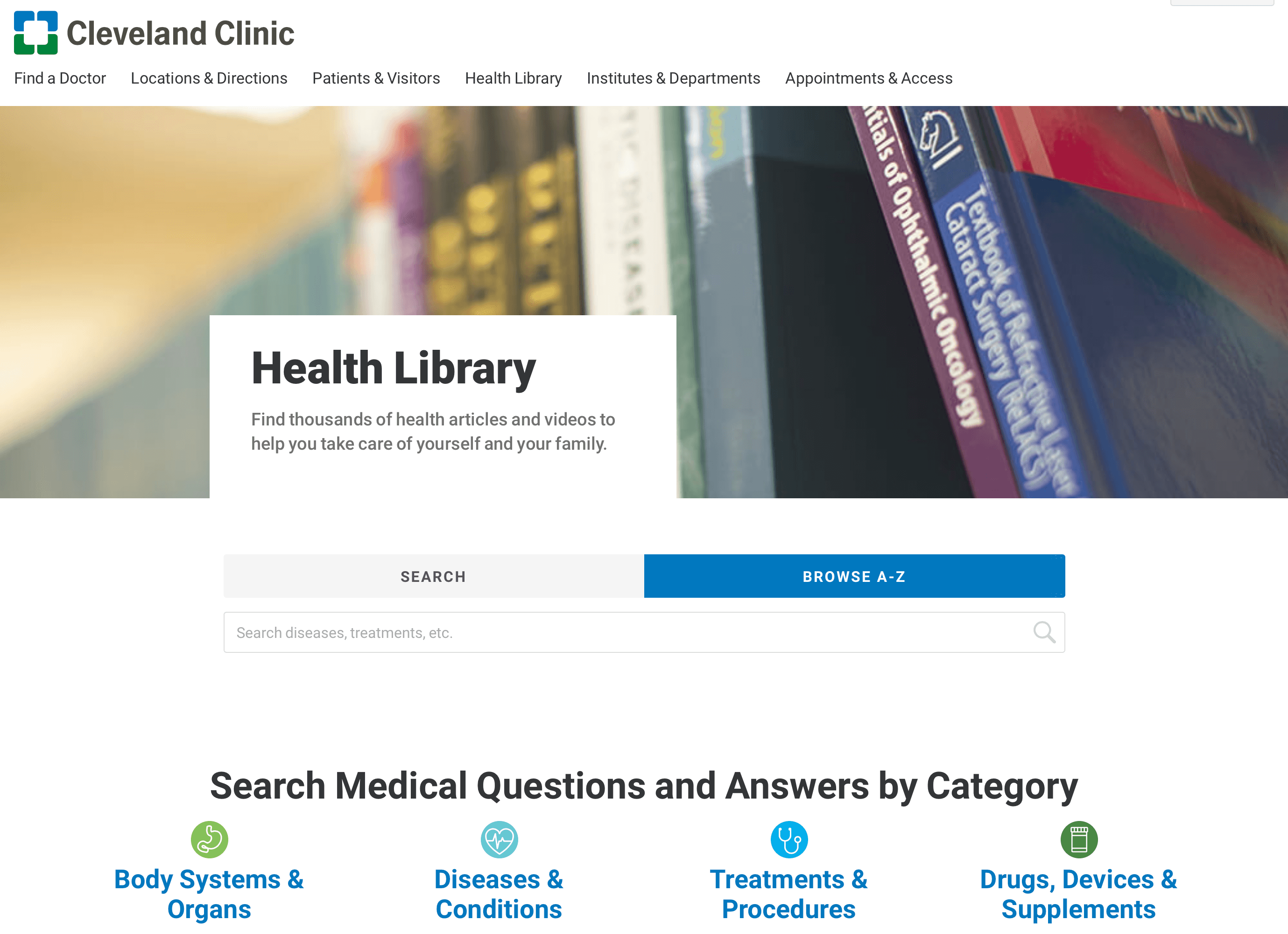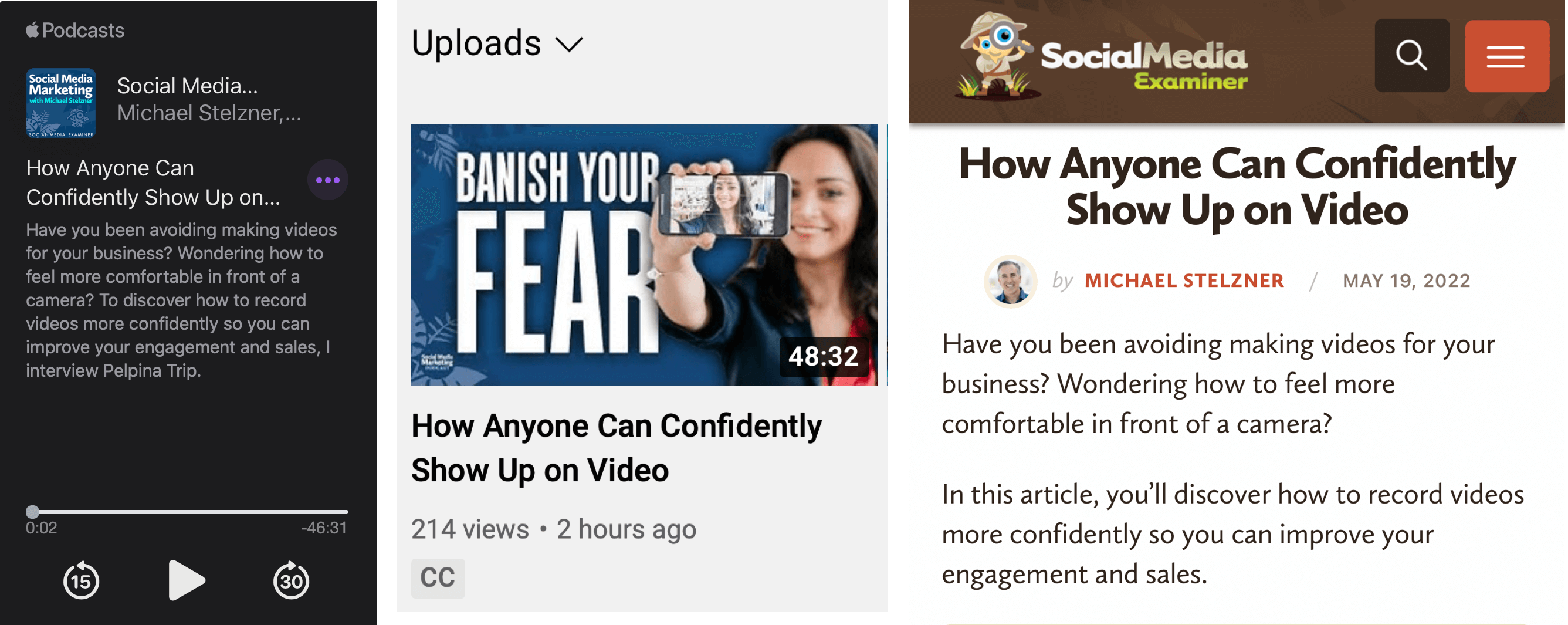Looking for something that can give you a unique edge? Wondering if creating the right content can raise you above the competition?
In this article, you'll discover why content can be your unique business differentiator and how to do it right the first time.

The Value Proposition of Content
John Battelle, the founder of Wired, said a decade ago, “All brands are publishers now.” It doesn't matter if you're a team of 1 or 100; we're all in the business of creating engaging content for our audiences that ultimately will turn some of them into customers.
In the past, your strategy around content might have been to entertain, deliver value, and inspire thought leadership across as many platforms as you could. Now it's different. You have to develop audience loyalty to the content you're creating.
It's not good enough anymore to just grab someone's attention for 5 minutes with your “Top 10 Best Practices” post. Your content needs to grab and hold your audience's attention and get them to want to spend time consuming it.
When we talk about what content means for business, what we're really talking about is communication. Think of your content strategy as a communication strategy. You need to figure out how you're going to communicate in a consistent way across multiple channels to draw in your audience and create differentiation and some level of competitive advantage.
Here's a framework you can follow to use content as a differentiator for your business.
#1: Build a Content Universe
One of the biggest mistakes marketers make with content is they're not building anything. They're simply answering the questions their audience has. While they might get some SEO benefits, once their audience gets their answer, they move on to something else.
For a long-term content strategy to work, stop thinking about content as an asset or a singular post. Instead, focus on building a content universe, where post number one is better because post number five exists, and post six is better because post number one exists.
A great metaphor for this is the Marvel cinematic universe. If you saw the first movie Iron Man, which was released in 2008, you might remember it as a fine movie. If you were asked to name the other movies from 2008 that competed with Iron Man, you might be able to come up with one or two, but probably not.
The reason you remember Iron Man is because that movie was the first step in a mapped universe spanning 10 years. Marvel strategically designed a collection of movies to work together, where each movie raises the tide for all of the other content pieces. Thor is better because Iron Man exists, and the first Iron Man is now a classic because Thor exists.

When you think about that strategy from a business perspective, it's about creating a content universe where people want to come in and stay. They want to read something else because it's related to other content you created. Instead of just one-off assets, the goal is to build a complete body of work that differentiates your business from your competitors.
Case Study: The Cleveland Clinic
One company that has successfully built a content universe is the Cleveland Clinic with its Health Library and Health Essentials blog. The true differentiator for what it has done there with content is to add uniqueness.
To understand Cleveland Clinic's success, think about how medical providers approached content creation a decade ago. Back then, they were trying to answer every question people asked about medical topics. When a user googled, “what is diabetes” or “what is asthma” and your hospital specialized in treating those conditions, you wanted to come up in search. It was a natural SEO strategy.
Get World-Class Marketing Training — All Year Long!
Are you facing doubt, uncertainty, or overwhelm? The Social Media Marketing Society can help.
Each month, you’ll receive training from trusted marketing experts, covering everything from AI to organic social marketing. When you join, you’ll also get immediate access to:
- A library of 100+ marketing trainings
- A community of like-minded marketers
- Monthly online community meetups
- Relevant news and trends updates
What ended up happening was a lot of companies started creating very commoditized, how-to, FAQ types of answers for every medical topic you can imagine. Many hospitals opted into that strategy.
Cleveland Clinic took a different approach. In addition to its Health Essentials blog, which is much more proactive content (like dieting and exercise), it wanted to create a differentiated library of conditions people might be dealing with. It wanted to compete with sites like WebMD.
Using medical professionals as subject-matter experts, it started going deep into those topics to differentiate the quality of the content. Yes, it got good SEO benefits. But more importantly, when Cleveland Clinic started sharing this content across social media and people started consuming it, it kept that audience. People found the content to be better than the health information they were getting from WebMD.

Cleveland Clinic is so good at creating this content that it's now getting paid to do it. It can do ads and sponsorships to help monetize the content, which allows continued investment in developing more quality content. It has incorporated its own mini-WebMD business into the Cleveland Clinic content strategy.
#2: Treat Your Content as a Product
When you start planning your content universe, it's helpful to approach your content platform the same way you would approach creating a product.
Most businesses, as they're developing a new product, take the time to plan and prioritize how that product fits into their overall business strategy. How does the product further their mission? How does it carry their brand? Yet they don't take this same approach when creating content.

Discover Proven Marketing Strategies and Tips
Want to go even deeper with your marketing? Check out the Social Media Marketing Podcast! Publishing weekly since 2012, the Social Media Marketing Podcast helps you navigate the constantly changing marketing jungle, with expert interviews from marketing pros.
But don’t let the name fool you. This show is about a lot more than just social media marketing. With over 600 episodes and millions of downloads each year, this show has been a trusted source for marketers for well over a decade.
For example, a business building a resource center might do an article on the top 10 reasons their industry is changing the first week, the top 20 reasons their product makes sense for consumers the next week, and so on. The content pieces they're creating don't relate to one another—they're not building a body of work.
They're just building assets that speak to whatever they're thinking about on a given day, or whatever the sales department or the company's CEO is asking for. Their editorial strategy is merely about following their daily whims.
When you look at your content platforms as products, though, it forces you to ask what your editorial strategy should look like on those platforms. How can you build a body of work where people will want to visit that platform and stay?
The businesses that are doing this successfully have built an editorial system in which the pieces all work in concert. As an example, consider an article like this one, which is based on a podcast interview. It was originally recorded as an audio podcast, then was repurposed as video for YouTube, and finally was engineered into this article with a podcast player embedded at the end.

When it comes to creating your own content, you should be thinking about what your content will look like across different formats and where your audience can find it.
Of course, marketers tend to think like marketers. The first thing they consider is the container for their content: is it a blog post, an ad, or a white paper? Once they identify what the container is, they focus on how they're going to fill that container.
But a great content strategy starts at the other end: what's the story and the value you want to provide to your audience? Then you build that out into different formats for different platforms.
The advantage of this approach is that it helps you think about all of the content needs you might have from the get-go. If you're planning to repurpose an audio podcast into a variety of content pieces, you can start assembling a workflow much more like a director would as they plot out how to shoot all of the scenes in a movie.
#3: Plan and Prioritize Content Creation
Businesses generally don't have trouble coming up with content ideas. The problem lies in finding the bandwidth to execute them. The reality is that you're never going to have enough people to execute a cohesive and coordinated content universe without prioritizing and planning your strategy.
Setting up this kind of process for your business starts with giving your content person or team the ability to say no. Recognize that not every idea that goes into an intake form or the idea box is going to fit your content universe.
It's also important to document the content you're currently responsible for creating. Think about this like an air-traffic controller keeping track of the planes in the sky. You and your team need to develop a content calendar that catalogs everything you're doing. This will provide visibility to everyone who depends on you to create content such as the sales team, social media managers, and video editors.
Once you've identified all of the planes in the air, so to speak, you can start talking about how best to direct them. While it's true that incorporating planning and prioritization into your content creation process will slow everything down, you're going to more than make up for it in your ability to repurpose content and populate multiple channels with multiple versions of that content.
Once you have a good prioritization and production process in place, you'll also be able to make more sound business decisions about when and how to improvise. Maybe you'll decide that trying something new makes sense but you don't have the in-house resources to do it. At that point, you can consider outsourcing or bringing in somebody new to create that content.
Robert Rose is a content strategist and founder of The Content Advisory, a consultancy that helps brands develop their content strategy. He's co-author of Killing Marketing and co-host of This Old Marketing podcast. Find Robert at @Robert_Rose on Twitter and @RobRose on LinkedIn.
Other Notes From This Episode
- Check out Cleveland Clinic's Health Essentials blog and Health Library.
- Connect with Michael Stelzner at @Stelzner on Instagram.
- Watch exclusive content and original videos from Social Media Examiner on YouTube.
- Tune into our weekly Social Media Marketing Talk Show. Watch live on Fridays at noon Pacific on YouTube. Listen to the replay on Apple Podcasts or Google Podcasts.
Listen to the Podcast Now
This article is sourced from the Social Media Marketing Podcast, a top marketing podcast. Listen or subscribe below.
Where to subscribe: Apple Podcasts | Spotify | YouTube Music | YouTube | Amazon Music | RSS
✋🏽 If you enjoyed this episode of the Social Media Marketing podcast, please head over to Apple Podcasts, leave a rating, write a review, and subscribe.
Stay Up-to-Date: Get New Marketing Articles Delivered to You!
Don't miss out on upcoming social media marketing insights and strategies! Sign up to receive notifications when we publish new articles on Social Media Examiner. Our expertly crafted content will help you stay ahead of the curve and drive results for your business. Click the link below to sign up now and receive our annual report!
Attention Agency Owners, Brand Marketers, and Consultants

Introducing the Marketing Agency Show–our newest podcast designed to explore the struggles of agency marketers.
Join show host and agency owner, Brooke Sellas, as she interviews agency marketers and digs deep into their biggest challenges. Explore topics like navigating rough economic times, leveraging AI, service diversification, client acquisition, and much more.
Just pull up your favorite podcast app, search for Marketing Agency Show and start listening. Or click the button below for more information.

